#overactivebladder
Explore tagged Tumblr posts
Text
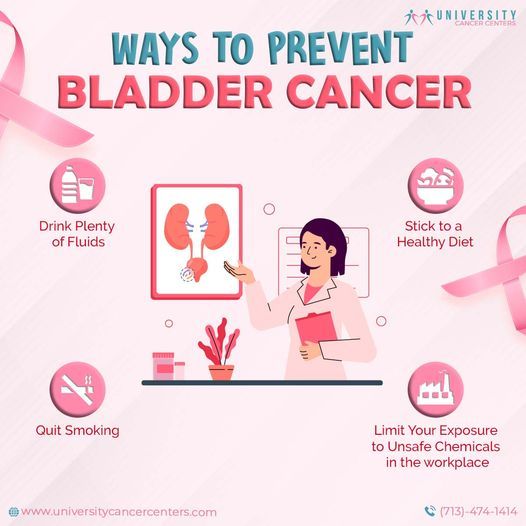
According to 2016 U.S. data bladder cancer mostly affects older people. About 90% of people with bladder cancer are older than 55. The average age people are diagnosed with bladder cancer is 73.
#endometriosis#endometriose#overactivebladder#bladderproblems#bladder#chronicillness#chronischziek#chronicpain#painproblems#1in10#pelvicfloorexercises#diastasisrecti#pelvicfloorphysio#bladderhealth#coreworkouts#universitycancercenter#bladdercancer
4 notes
·
View notes
Video
youtube
Incontinix VigRX Review | Is Incontinix Good for Overactive Bladder?
0 notes
Text
Understanding Overactive Bladder: A Common Condition
Overactive Bladder (OAB) occurs with millions of women and is characterized by the sudden bladder detrusor contractions, which interfere with daily activities. This paper seeks to identify the symptoms of this disorder and its suitability for management. Key Symptoms of OAB: 1.Frequent Urination: Probably, you are likely to end up making several visits to the toilet throughout the day. 2.Urge Incontinence: This is when you find yourself wetting the undergarment after having a feel of the urge to pass urine. 3.Nocturia: Another is frequent nighttime trips to the bathroom to urinate; What Causes OAB? OAB results from dysfunctional communication between the brain and the bladder forcing the muscles of the bladder to contract uncontrollarily. Treatment Options: Management may be profiled with lifestyle changes first of all, including terms of caffeine and alcohol. Bladder control and including following the number of times you visit the washroom can also help. If symptoms endure one may have to seek the help of a doctor for medications purposes. Knowledge about OAB can help women out there get the support that they need to be in control again in their lives.
Read more: Overactive Bladder
0 notes
Text
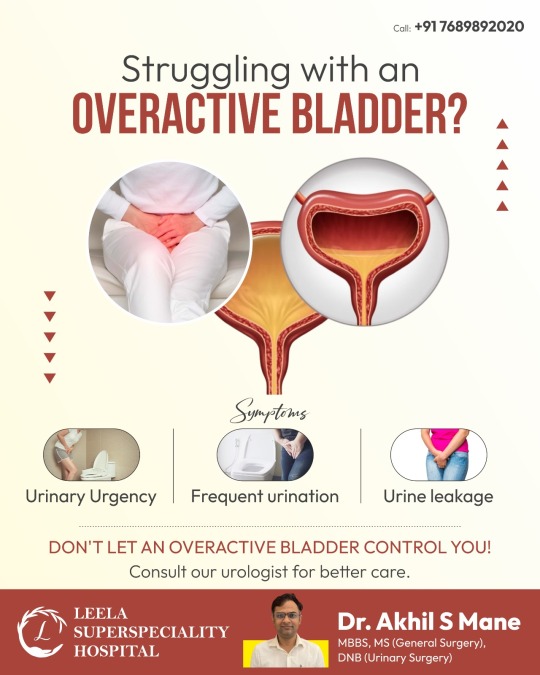
𝐇𝐨𝐰 𝐢𝐬 𝐎𝐯𝐞𝐫𝐚𝐜𝐭𝐢𝐯𝐞 𝐁𝐥𝐚𝐝𝐝𝐞𝐫 (𝐎𝐀𝐁) 𝐭𝐫𝐞𝐚𝐭𝐞𝐝? 𝐃𝐫. 𝐀𝐤𝐡𝐢𝐥 𝐒. 𝐌𝐚𝐧𝐞 𝐩𝐫𝐨𝐯𝐢𝐝𝐞𝐬 𝐭𝐡𝐞 𝐛𝐞𝐬𝐭 𝐭𝐫𝐞𝐚𝐭𝐦𝐞𝐧𝐭 𝐟𝐨𝐫 𝐎𝐯𝐞𝐫𝐚𝐜𝐭𝐢𝐯𝐞 𝐁𝐥𝐚𝐝𝐝𝐞𝐫. An overactive bladder, also known as OAB is a condition characterized by sudden uncontrollable urges to urinate, often resulting in frequent trips to the bathroom and in some cases, involuntary leakage of urine. Dr Akhil S Mane is a renowed urologist specializing in treating various urological conditions including overactive bladder. with over 13+ years of experience, he offers advanced treatments for urological issues at Leela Superspeciality Hospital, wakad, Pune. To book an appointment with Dr. S. Mane's approach to treating an overactive bladder, you can visit the Leela Superspeciality Hospital website. 📍 Leela Superspeciality Hospital, Wakad 📞 Contact: +91 96 3731 1000 / +91 76 8989 2020 🌐 Website: www.leelasuperspecialityhospital.com 💾 Save this post | 📤 Share with friends | 💬 Comment if you found this helpful! (causes of overactive bladder in women, overactive bladder, overactive bladder treatment options, urologist in pune for kidney stones, Dr. Akhil S Mane urology services, Dr. Akhil S Mane Urology Clinic, Top urologist in pune) #urologist #urology #overactivebladder #bladder #urinary #urinaryurgency #frequenturination #urineleakage #besturologist #topurologist #leelasuperspecialityhospital #drakhilsmane #drakhilmane
#overactive bladder#overactive imagination#overactive bladder in women#top urologist in pune#dr. akhil S Mane#leelasuperspecalityhospital
1 note
·
View note
Video
youtube
THE 5 BEST TREATMENTS for Overactive Bladder, Urination Frequency
➤ TitanFlow Official Site [100% SAFE] ✅ TITANFLOW: https://bit.ly/44i6rGj In this video, I showed you the main symptoms and the five most effective treatments for overactive bladder, a common condition that causes urgency and frequent urination, especially in older individuals. You will learn how lifestyle changes, dietary adjustments, and treatments such as pelvic floor physiotherapy and medications can help control overactive bladder. You will understand how adopting new habits can reduce urination frequency and significantly improve symptoms of bladder issues. #bladderincontinence #overactivebladder #urinationfrequency #titanflow 00:00 What is Overactive Bladder 00:55 1st Treatment for Urination Frequency 01:21 2nd Treatment for Overactive Bladder 01:44 3rd Treatment for Urination Frequency 02:01 4th Treatment for Overactive Bladder 03:05 5th Treatment for Urination Frequency Share this video: https://youtu.be/3wiZqmBCCfE
0 notes
Text
#Shorts - Bladder Infection | Best Urology Hospital in Bangalore | Nelivigi Urology Hospital
Best Urology Hospital in Bangalore | Nelivigi Urology Hospital. A bladder infection, also known as cystitis, is a common urinary tract infection (UTI) that occurs when bacteria enter and multiply in the urinary bladder. Bladder infections can be uncomfortable and painful but are typically not considered serious if treated promptly.
Watch it Now!!!
To know more log on to http://www.nelivigimultispecialityhospital.com/ or to book an appointment call us @ 63662 08767
#NelivigiMultispecialityHospital #NationalBladderHealthMonth #DrGirishNelivigi #BladderHealthMonth #BladderHealth #NelivigiMultispeciality #NelivigiUrology #Doctor #Urologist #Urologists #Urology #Kidneystones #OveractiveBladder #Bladder #BladderHealth #UrinaryTractInfection #BladderProblems #UrinarySystem #UTI #Urinary #kidneyinfection #health #Bellandur #Bangalore
0 notes
Text
What are the suggestions for improving urinary incontinence?
Ingest a moderate amount of fluids.Ingest more fluids(not including alcohol or caffeine) can reduce urinary incontinence. If you don't have enough fluid, your urine will be concentrated. Concentrated urine will irritate your bladder wall, causing it to contract more frequently, making you feel urgency. Of course, avoiding fluid intake before going to bed and before going out can reduce accidents.🔸
Reduce alcohol intake. Drinking alcohol can aggravate urinary incontinence. Alcohol can also cause unnecessary bladder contractions. Reducing alcohol intake or stopping drinking can help improve symptoms.🧡
lose weight. Being overweight can put extra pressure on the pelvic floor muscles. This extra pressure weakens the muscles. If you are overweight, losing weight can improve your symptoms. The best way to lose weight is to change your diet and exercise regularly.🧐
2 notes
·
View notes
Text
Difference Between Overactive Bladder and Incontinence
Interruptions in the body’s natural way of functioning can be challenging and frustrating to deal with. One such condition—urine leakage can not only restrict a sufferer’s lifestyle and freedom of movement, but also impair their mental health due to prevailing social stigma.
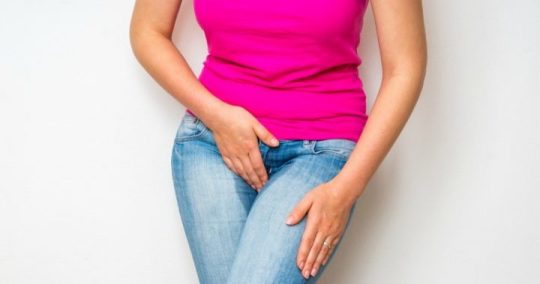
As patients, caregivers or family members the best we can do in such situations is to stay informed and aware of the best practices to help sufferers cope with dignity and ease.
Incontinence Vs Overactive Bladder
We’ve all seen advertisements for adult diapers and are familiar with the product. However, little awareness exists on the conditions that necessitate the use of adult diapers. Two names that commonly come up alongside the mention of disposable adult diapers are urinary incontinence and overactive bladder.
Both these conditions involve malfunctions in the urinary bladder that result in premature or unexpected bladder contractions or pelvic muscle contractions.
However, they are not the same. Overactive bladder is a condition that involves issues with one’s urge to urinate. Urinary incontinence, meanwhile, is not a condition, it is a symptom. This occurs when one loses control of their bladder causing the frequent or uncontrolled leakage of urine.
Let us explain in detail.
Overactive Bladder
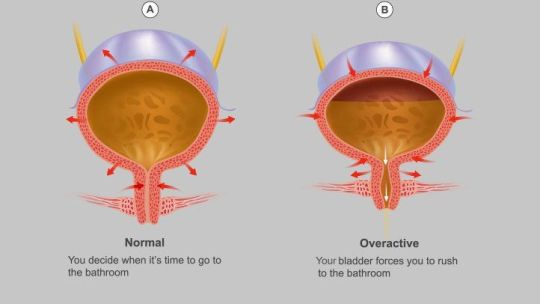
Overactive or irritable bladder is basically classified as experiencing sudden, overwhelming urges to urinate.
Usually, after a person’s bladder fills close to its capacity with urine, the bladder sends a signal to the brain. The brain interprets this and sends a message back to the urethra, signalling that it must open and empty the bladder. This same signal is interpreted by our conscious selves as the urge to urinate, requiring us to find a toilet. However, in a patient with an overactive bladder, this system of signals is interrupted.
Instead of starting as a mild need to urinate, getting stronger as the bladder fills; a person with an Overactive Bladder may only receive strong, urgent signals; even when the bladder is not entirely full. An Overactive Bladder can also cause patients to experience a more frequent need to urinate, requiring them to rush to the toilet more than eight times during the day and over twice at night.
Overactive bladders are more commonly experienced by women and may be caused due to neurological conditions such as multiple sclerosis, Parkinson’s, stroke or diabetes. Overconsumption of diuretics such as alcohol and caffeine, which cause the body to produce more urine, can also contribute to the condition. However, for most people the cause is unknown.
Pelvic floor exercises, Kegels, weight loss and bathroom training can help in a large way to manage urinary incontinence. In the last few years with greater access and lowering in prices, the use of adult diapers have become increasingly common. Overnight diapers for adults can especially help both sufferers and their caregivers receive much needed rest at night.
Oral medications and Botox injections are also becoming increasingly popular in dealing with the condition. However, surgeries are not often fool proof especially in elderly patients with other health complications.
Urinary incontinence
Urinary incontinence, meanwhile, has more to do with a failure in the structure of the urinary system. This usually happens when pelvic floor muscles that support the urinary system weaken, allowing urine to seep out of the bladder due to activities that stress these muscles.
Urinary incontinence can be of five types:
Stress incontinence - when activities such as coughing, sneezing, laughing, exercising or lifting something heavy exert a pressure on bladder muscles causing them to squeeze out urine.
Urge incontinence - this resembles an overactive bladder and may be caused due to a sudden urge to urinate followed by the involuntary loss of urine.
Overflow incontinence - when you experience a constant leak or dribbling of urine, perhaps in tiny spurts, due to a bladder that fails to empty completely.
Functional incontinence - when a physical or mental impairment such as say arthritis stops you from reaching the toilet in time.
Mixed incontinence - when one experiences a mixture of these types.
Urinary incontinence is often induced as a by-product of ageing which may cause the loosening and weakening of one’s pelvic muscles; or post-surgery, post-pregnancies and due to obesity. It occurs in both men and women and is often handled simply by the use of disposable adult diapers.
Adult diapers are unisex and easy to use. They come in pant-style and tape-style and also have overnight adult diaper variations. Various brands now manufacture disposable adult diapers that can be used up to 16 hours without discomfort. Adult diapers with anti-bacterial technologies can also help keep dampness and skin rashes caused due to cloth liners at bay.
Differences in Overactive Bladder and Urinary Incontinence
Thus, to recap, the frequent urge to urinate, and use of adult diapers and pelvic floor muscle exercises as methods of management, are common to both overactive bladder and urinary incontinence. The differences between the two are as follows:
Overactive bladder is a condition in itself while urinary incontinence is usually a symptom of a different cause.
Overactive urge has more to do with the urge to urinate while urinary incontinence pertains to the actual leakage of urine.
While both are related to the urge to urinate, the urge caused by an overactive bladder may not actually be followed by urine leakage.
Urinary incontinence has more to do with a weakening of muscles while an overactive bladder is linked to neurological issues.
Overactive bladder commonly affects women, while urinary incontinence, often as a by-product of ageing affects both men and women equally.
The normal adult bladder can hold up to 300-400ml (roughly 2 cups) of urine during the day and up to 800ml (4 cups) during the night. Issues that disrupt the functioning of the bladder can be difficult to deal with. But with the right attitude, support, exercises and a few adult diapers everything can be managed.
Image Source: https://startsat60.com, www.everydayhealth.com
19 notes
·
View notes
Video
instagram
Got Pelvic Pain? Learn your pain management options from a Gynecologic Surgeon & Certified Medical Support Hypnotherapist. 💜Instagram Live 6.9.20 4pm ET, join here: @audrey_wasatch_hypnotherapy #pelvicpain #interstitialcystitis #endometriosis #overactivebladder #pelvicfloor #gynecology #mindfulness #hypnosis #urinaryincontinence (at Heber City, Utah) https://www.instagram.com/p/CBOUglZjwCI/?igshid=1fco554qvmofb
#pelvicpain#interstitialcystitis#endometriosis#overactivebladder#pelvicfloor#gynecology#mindfulness#hypnosis#urinaryincontinence
2 notes
·
View notes
Text

One prevalent form of cancer that starts in the bladder's cells is bladder cancer.
According to The American Cancer Society's estimates for bladder cancer in the United States for 2023 are: About 82,290 new cases of bladder cancer (about 62,420 in men and 19,870 in women) About 16,710 deaths from bladder cancer (about 12,160 in men and 4,550 in women)
#endometriosis#endometriose#overactivebladder#bladderproblems#chronischziek#chronicpain#painproblems#universitycancercenter#bladdercancer#coretraining#coreworkouts#bladderhealth#pelvicfloorphysio#diastasisrecti#pelvicfloorexercises
3 notes
·
View notes
Text
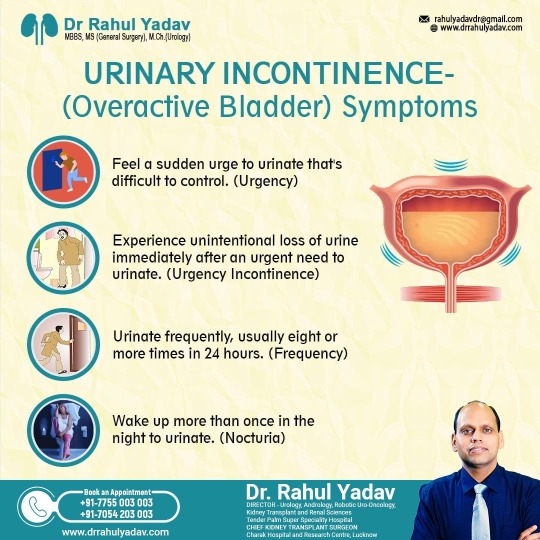
Urinary Incontinence - ( Overactive Bladder) symptoms
✔️ Urgency ✔️ Urgency Incontinence ✔️ Frequency ✔️ Nocturia
For more information 🌐𝐕𝐢𝐬𝐢𝐭: https://drrahulyadav.com 👉🏻𝐁𝐨𝐨𝐤 𝐘𝐨𝐮𝐫 𝐀𝐩𝐩𝐨𝐢𝐧𝐭𝐦𝐞𝐧𝐭: +91 77550 03003
#Urologist#Bladder#Urinaryincontinence#besturologist#overactivebladder#overactivebladdersymptoms#drrahulyadavurologist
0 notes
Text
Managing an OverActive Bladder
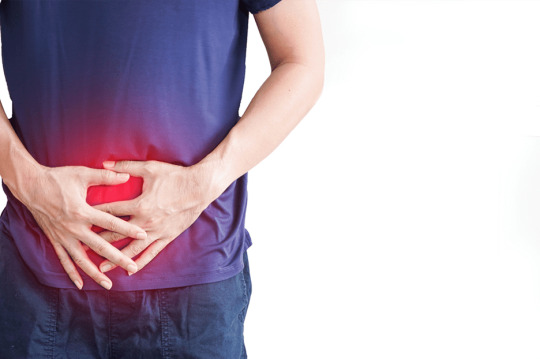
Are you feeling like you constantly need to go? Are you unable to get out of the home of worry of always needing the restroom? You are one of the many. More than 33 million Americans suffer from an overactive bladder. Overactive Bladder (OAB) is an ordinary disorder that can affect up to approximately 40% of women in their lifetime. OAB can result in urinary incontinence - the loss of bladder control, clearly an embarrassing issue. Those with OAB also called urge incontinence, experience a hasty, strong urge to urinate during the daytime and nighttime; they may also dribble before reaching the restroom.
What is an OverActive Bladder? Overactive Bladder (OAB) provokes a frequent and hurried urge to urinate that may be tough to restrain. You may feel like you ought to pass urine numerous times during the day and night, and may also experience involuntary discharge (urgency incontinence). OAB results in someone needing to discharge more than the usual 7 to 8 times per 24 hours. Therefore, OAB generally consists of four symptoms: an urgent necessity to urinate a need to urinate more often than average waking from sleep to urinate haste incontinence (urine leakage). OAB is not due to the consequences of urinary tract infection or a neurologic disorder such as multiple sclerosis, and your physician should rule this out.
Who is at risk for developing OAB?
Though OAB can transpire to anyone, some individuals are more prone than others, and the probabilities increase for mostly all of us as we age. Women have a slightly more elevated risk than men, thanks to bladder modifications after menopause.
Other factors contributing to OAB enclose obesity, smoking, and diabetes, as well as:
Specific pharmaceuticals Enlarged prostate or equivalent bottlenecks Disproportionate caffeine and liquor infusion A neurodegenerative disorder such as Parkinson's, multiple sclerosis, or stroke Mobility problems, including arthritis
How is OAB diagnosed? To appropriately diagnose your OAB—and eradicate other potential reasons for incontinence—your healthcare provider will need a precise medical record. Physical and neurological exams may be regulate, as will a urine examination and conceivably a bladder scan.
Along with many other diagnostic tools, your physician may also use a uroflowmetry to gauge your urine volume, or cystometry, which calculates how your urine flow relates to your bladder pressure. What are the treatments for this condition? Once your OAB has been diagnosed, the first sequence of treatment will most probably be workouts and behavioral transformations—something you can do by yourself, at home. You may be asked to cut back on caffeine and alcohol or to shed a few pounds. The doctor might tell you to drink fewer fluids, particularly close to bedtime. You may be appointed one or more of the subsequent exercises: Kegels, during which you bend and hold your pelvic floor muscles to enhance bladder control
Bladder training, during which you rehearse being able to retain your urine for longer and longer durations
Scheduled voiding, during which you set certain periods of the day for bathroom trips until you don't feel the longing to urinate at different times Keeping a bladder journal, where you record when and how considerably you pee, can also help pinpoint your triggers. A word from the team — OAB can make everyday life difficult, but you're not alone in this fight. You may find support and ideas to cope with OAB from friends, family, your healthcare provider, and others who are also suffering from the condition. Reach out to them and get help as soon as possible! So, if you need further help regarding your health and wellness and want to know how you can manage your OAB, contact Corrielus Cardiology today!
Source: Managing an OverActive Bladder
0 notes
Photo
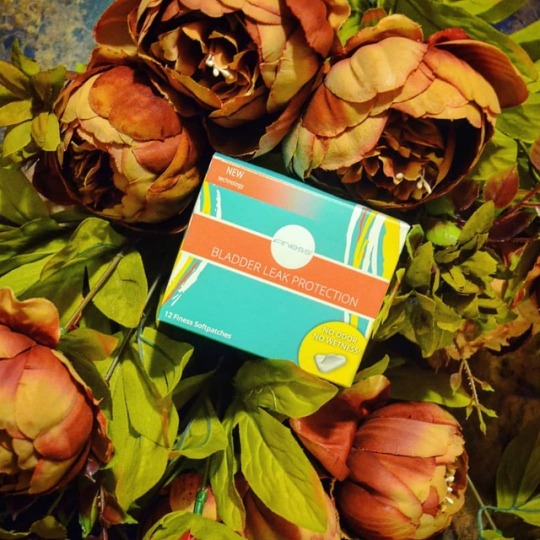
Working as a home health #registerednurse for 10+ years I have encountered countless women of all ages who experience #bladderleaks from everyday activities like running, laughing, sneezing etc.. I wish this new innovative @HaveFiness product was available back then because I would of recommended it 😀 #Finess doesn’t simply catch leaks it actually prevents them from happening in the first place! This is a perfect solution for for women with mild to moderate #bladderleakage. These #HaveFiness are made of a super soft foam that molds to your body for comfort and a gentle hydrogel adhesive that is easy to place over the area leaks occur... best of all It’s not a pad! . I know this is an uncomfortable subject but I am more than happy to bring light to the new solutions out there for this common problem many woman experience 🙆 #LiveLifeLeakFree . Visit @HaveFiness to learn more about this innovative new product that can really make a difference in many women's lives 😀 https://havefiness.com -- clickable link in my bio & blog . . . . . . . . . ❤ #sponsored #momslife, #momlife, #yogagirl #fitfam #pelvicfloorhealth #newmommy #healthmatters #womenempoweringwomen #femalebody #postpartumbody #postpartumjourney #postpartumhealth #postpartumlife #postpartumrecovery #thisismotherhood #momslifeisthebestlife #incontinence #50plusandfabulous #40andfabulous #bladderhealth #overactivebladder #fiercewomen #femaleempowerment (at California)
#bladderleaks#momslife#postpartumbody#newmommy#40andfabulous#fiercewomen#havefiness#registerednurse#overactivebladder#bladderhealth#pelvicfloorhealth#postpartumlife#livelifeleakfree#momlife#womenempoweringwomen#femalebody#50plusandfabulous#femaleempowerment#healthmatters#postpartumrecovery#thisismotherhood#fitfam#postpartumhealth#incontinence#yogagirl#momslifeisthebestlife#finess#bladderleakage#sponsored#postpartumjourney
1 note
·
View note
Link
ओवरएक्टिव ब्लैडर Overactive bladder , जिसे अतिसक्रिय मूत्राशय के रूप में जाना जाता है, एक ऐसी समस्या है जिसके परिणामस्वरूप अचानक पेशाब करने और मूत्राशय के नियंत्रण में संभावित नुकसान होता है।
0 notes
Link
We at Excel Research Clinic have in house therapists who are adept at what they do. Our organized and smooth processing enables us to produce the highest quality data in short periods of time. Our researchers have been conducting experiments for the past 25 years and our facilities are second to none. Just visit our website to find out more about our services and how we aim to improve the globe as a whole.
0 notes
Photo
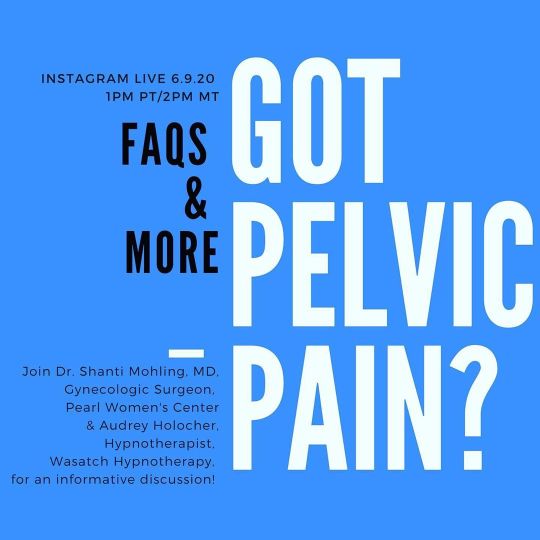
#chronicpain #pelvicpainawareness #interstitialcystitis #endometriosis #gynecologist #pelvicpain #interstitialcystitisawareness #naturalpainrelief #hypnotherapy #hypnosis #stressrelief #womenshealthmatters #painfulsex #endometriosiswarrior #urinaryincontinence #overactivebladder #shantimohlingmd #wasatchhypnotherapy #overactivebladder #stressurinaryincontinence #obstretrics #pelvicfloormuscletraining #pelvicfloormuscles #leakage #mypelvicfloormuscles #pelvicfloortraining (at Portland, Oregon) https://www.instagram.com/p/CBHegzijH5N/?igshid=1g3bif0b4zpwy
#chronicpain#pelvicpainawareness#interstitialcystitis#endometriosis#gynecologist#pelvicpain#interstitialcystitisawareness#naturalpainrelief#hypnotherapy#hypnosis#stressrelief#womenshealthmatters#painfulsex#endometriosiswarrior#urinaryincontinence#overactivebladder#shantimohlingmd#wasatchhypnotherapy#stressurinaryincontinence#obstretrics#pelvicfloormuscletraining#pelvicfloormuscles#leakage#mypelvicfloormuscles#pelvicfloortraining
0 notes